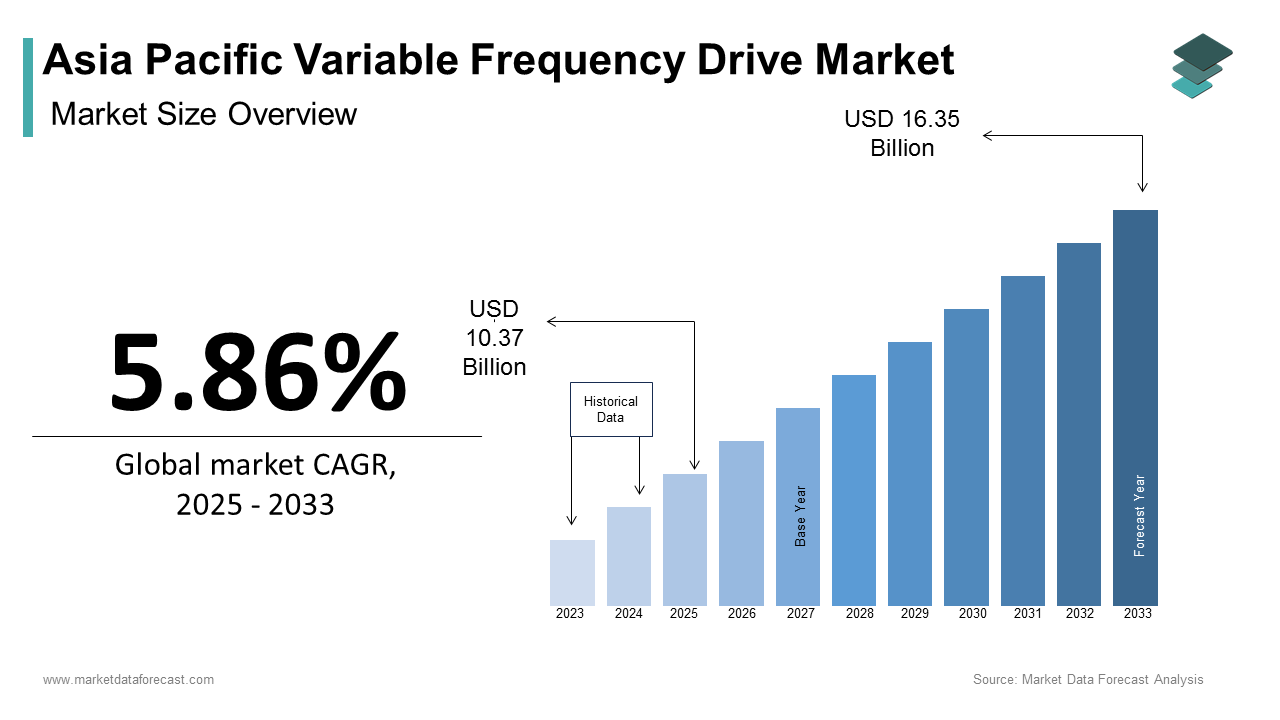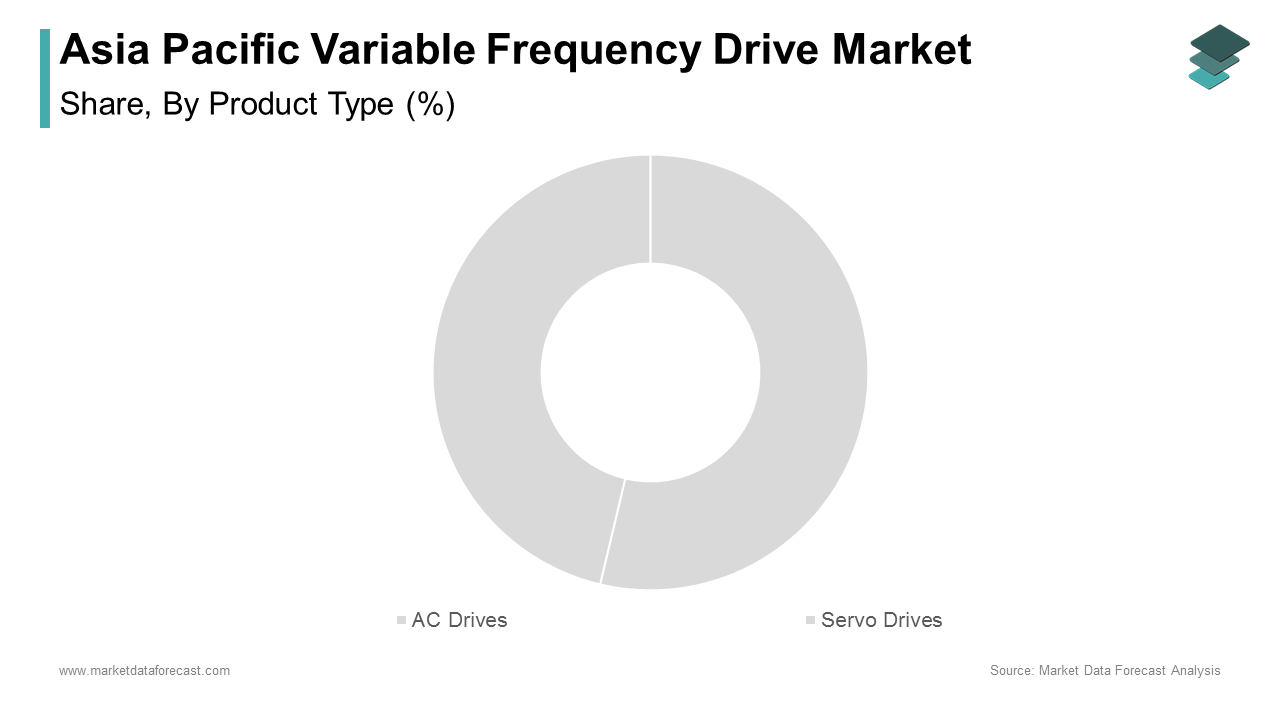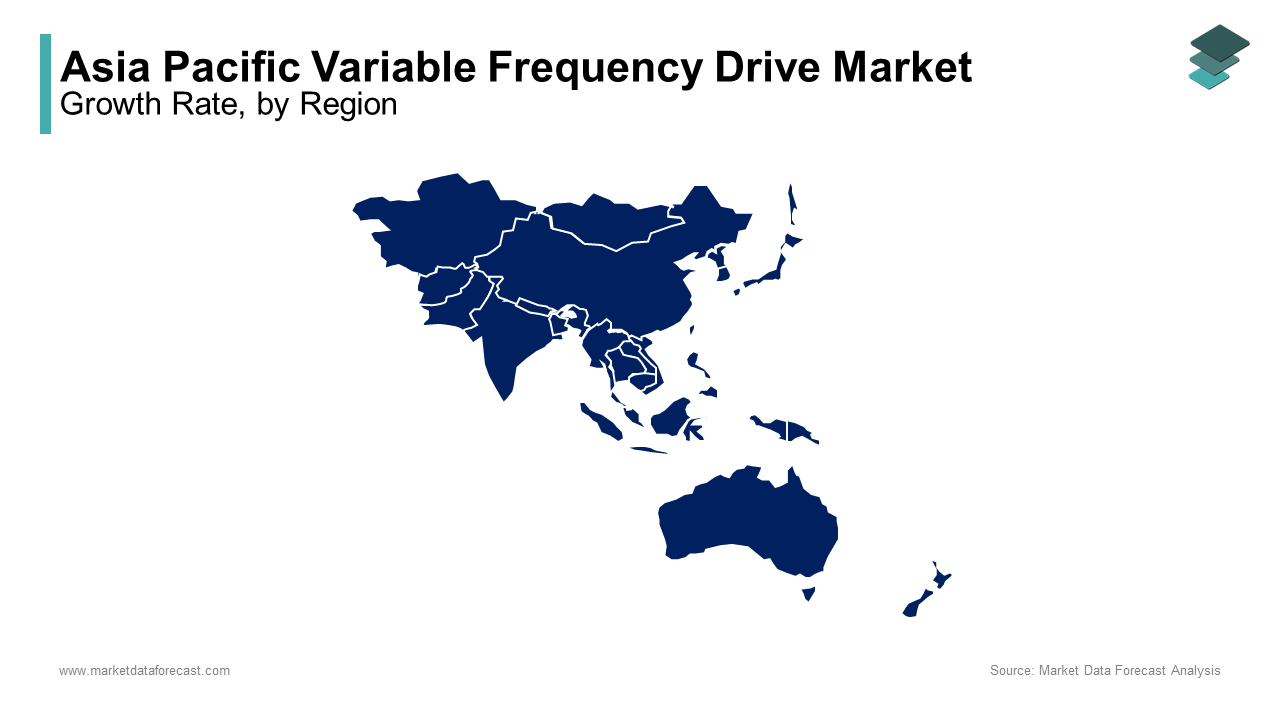Asia Pacific Variable Frequency Drive Market Size, Share, Trends & Growth Forecast Report By Product Type (AC Drives , Servo Drives), Application, And Country (India, China, Japan, South Korea, Australia, New Zealand, Thailand, Malaysia, Vietnam, Philippines, Indonesia, Singapore And Rest of Asia-Pacific), Industry Analysis From 2025 To 2033
Asia Pacific Variable Frequency Drive Market Size
The Asia Pacific variable frequency drive market size was calculated to be USD 9.80 billion in 2024 and is anticipated to be worth USD 16.35 billion by 2033, from USD 10.37 billion in 2025, growing at a CAGR of 5.86% during the forecast period.

MARKET DRIVERS
Industrial Automation and Smart Manufacturing
Industrial automation and smart manufacturing serve as primary drivers for the Asia Pacific VFD market. It is fueled by the region's push toward Industry 4.0. Government initiatives further amplify this trend. Like, subsidies for industrial automation have increased in the past few years, encouraging manufacturers to adopt VFDs. Additionally, the rise of IoT-enabled factories creates new opportunities, as VFDs integrate seamlessly with smart systems for real-time monitoring and predictive maintenance. These factors collectively show how industrial automation and smart manufacturing act as formidable catalysts for the VFD market in the region.
Energy Efficiency Regulations
Energy efficiency regulations are another critical driver propelling the Asia Pacific VFD market, particularly amid growing concerns about climate change and resource conservation. Like, industrial motors account for for a notable share of global electricity consumption, making them a prime target for energy-saving measures. For instance, Japan’s Top Runner Program mandates the use of energy-efficient equipment, including VFDs, in manufacturing facilities. Similarly, India’s Perform, Achieve, and Trade (PAT) scheme incentivizes industries to reduce energy consumption by adopting advanced technologies like VFDs. The surge in renewable energy projects further amplifies demand. BloombergNEF reports that Asia Pacific accounted for 57% of global renewable energy capacity additions in 2022, necessitating VFDs for wind turbine pitch control and solar tracking systems. Additionally, urbanization trends drive the adoption of VFDs in HVAC systems for commercial buildings. These regulatory and environmental factors collectively reinforce the pivotal role of energy efficiency mandates in shaping the VFD market’s growth trajectory.
MARKET RESTRAINTS
High Initial Costs
High initial costs pose a significant restraint to the Asia Pacific VFD market, deterring small and medium enterprises (SMEs) from adopting the technology despite its long-term benefits. This financial barrier is particularly pronounced in emerging economies like Vietnam and Indonesia, where capital expenditure remains a key concern. Moreover, the complexity of installation and integration further compounds the issue. A study by the Asian Development Bank highlights that over 60% of SMEs in the region lack the technical expertise required for VFD deployment, leading to hesitation. While larger corporations can absorb these costs, smaller players often prioritize short-term affordability over long-term efficiency gains. Consequently, high initial costs not only hinder market inclusivity but also slow down the widespread adoption of VFDs, limiting the market’s potential to fully leverage its growth opportunities.
Technical Complexity and Maintenance Challenges
Technical complexity and maintenance challenges present another major restraint for the Asia Pacific VFD market, particularly in industries with limited technical expertise. Also, a significant share of industrial operators in emerging economies lack adequate training in advanced motor control technologies, resulting in operational inefficiencies. For instance, improper installation or calibration of VFDs can lead to motor overheating or resonance issues, increasing downtime and repair costs. Additionally, the need for regular maintenance amplifies operational expenses. Furthermore, the lack of skilled technicians exacerbates the problem which notes a significant skills gap in industrial automation. These challenges not only undermine customer confidence but also restrict market penetration, forcing stakeholders to invest heavily in training and after-sales support to address these barriers effectively.
MARKET OPPORTUNITIES
Adoption of IoT-Enabled VFDs
The adoption of IoT-enabled VFDs presents a transformative opportunity for the Asia Pacific VFD market, enabling manufacturers to enhance operational efficiency and cater to evolving customer demands. Also, IoT integration in industrial equipment is projected to boost productivity, offering a competitive edge. For instance, smart VFDs equipped with real-time monitoring and predictive maintenance capabilities are gaining traction in countries like South Korea and Japan, where precision and reliability are paramount. These technologies enable proactive fault detection, reducing downtime and operational costs.
China, a leader in digital innovation, is spearheading the adoption of IoT-enabled VFDs in smart factories. Additionally, remote-controlled systems are becoming essential in hazardous environments, such as mining and chemical processing, enhancing worker safety.
Rising Investments in Renewable Energy Projects
Rising investments in renewable energy projects offer a significant growth avenue for the Asia Pacific VFD market, driven by the region’s commitment to sustainability. According to BloombergNEF, renewable energy capacity in Asia Pacific is expected to double by 2030, surpassing 2,000 gigawatts. This expansion necessitates advanced motor control solutions, particularly for wind turbine pitch control and solar tracking systems. For example, India’s target to achieve 500 GW of renewable energy capacity by 2030 will require extensive VFD deployment, creating a robust demand pipeline. Similarly, China’s dominance in the solar panel manufacturing sector drives the need for specialized VFDs in production facilities. A report by the International Energy Agency highlights that China installed over 87.41 GW of solar capacity in 2022 alone, underscoring the scale of opportunities. Offshore wind projects, particularly in Vietnam and Taiwan, further amplify VFD demand due to their complex installation requirements.
MARKET CHALLENGES
Intense Market Competition
Intense market competition poses a formidable challenge for the Asia Pacific VFD market, characterized by the presence of numerous domestic and international players vying for market share. This overcrowded landscape results in price wars, eroding profit margins, and straining smaller players. For instance, Chinese manufacturers dominate the market with cost-effective offerings, leveraging economies of scale to undercut competitors. India and Southeast Asia witness similar dynamics, where local players struggle to compete with established brands. Additionally, the lack of product differentiation limits growth opportunities, forcing companies to focus on aggressive marketing strategies rather than innovation. Intellectual property disputes further complicate the scenario, with allegations of design infringements being common.
Skilled Labor Shortages
Skilled labor shortages represent another pressing challenge for the Asia Pacific VFD market, undermining operational efficiency and hindering growth. According to the International Labour Organization, the industrial automation sector faces a deficit of skilled operators, particularly in emerging economies like India and Indonesia. For instance, a survey by the Associated Chambers of Commerce and Industry of India reveals that nearly 40% of manufacturing projects experience delays due to a lack of trained personnel. This shortage is exacerbated by the rapid pace of industrial modernization, which outstrips workforce availability.
Furthermore, the complexity of modern VFDs, equipped with advanced technologies, requires specialized training, which is often inaccessible to workers in rural areas. A report by the Asian Development Bank highlights that vocational training programs in the region remain inadequate, leaving a significant skills gap. This scarcity not only impacts project timelines but also increases operational risks, as untrained personnel are more prone to accidents.
REPORT COVERAGE
|
REPORT METRIC |
DETAILS |
|
Market Size Available |
2024 to 2033 |
|
Base Year |
2024 |
|
Forecast Period |
2025 to 2033 |
|
CAGR |
5.86% |
|
Segments Covered |
By Product Type, Application, And Region |
|
Various Analyses Covered |
Global, Regional & Country Level Analysis; Segment-Level Analysis; DROC, PESTLE Analysis; Porter’s Five Forces Analysis; Competitive Landscape; Analyst Overview of Investment Opportunities |
|
Regions Covered |
India, China, Japan, South Korea, Australia, New Zealand, Thailand, Malaysia, Vietnam, Philippines, Indonesia, Singapore, Rest of Asia-Pacific |
|
Market Leaders Profiled |
ABB Ltd., Siemens AG, Schneider Electric SE, Danfoss Group, Rockwell Automation Inc., Mitsubishi Electric Corporation, Fuji Electric Co. Ltd., Hitachi Ltd., Yaskawa Electric Corporation, Toshiba International Corporation, Delta Electronics Inc., WEG S.A. |
SEGMENTAL ANALYSIS
By Product Type Insights

The AC drives segment dominated the Asia Pacific variable frequency drive market by commanding a 70.4% share in 2024. This dominance is driven by their versatility and energy efficiency, making them ideal for applications in pumps, HVAC systems, and conveyors. Like, AC drives are projected to reduce motor energy consumption, aligning with regional mandates for energy conservation. For instance, China’s "14th Five-Year Plan" allocates $150 billion to industrial modernization, emphasizing the adoption of AC drives in manufacturing facilities. Another key factor is the widespread use of AC motors in industrial machinery. A report by the Asian Development Bank highlights that over 80% of industrial motors in the region are AC-based, necessitating compatible drives. Additionally, advancements in IoT-enabled AC drives enhance their appeal, particularly in smart factories.
The servo drives segment is the fastest-growing in the Asia Pacific variable frequency drive market, with a projected CAGR of 12.5% through 2033. This is fueled by their precision and adaptability in high-performance applications like robotics and CNC machines. For example, South Korea’s electronics sector, led by companies like Samsung and LG, relies heavily on servo drives for automated assembly lines, driving regional demand. The rise of Industry 4.0 further amplifies adoption. Additionally, the proliferation of electric vehicles (EVs) creates new opportunities, as servo drives are integral to EV production lines.
By Application Insights
The pumps segment represented the largest application in the Asia Pacific variable frequency drive market by holding a 35.3% share in 2024. This dominance is driven by the region’s extensive reliance on water management systems, particularly in agriculture and urban infrastructure. One key factor is the growing emphasis on sustainability. For instance, India’s Jal Shakti Abhiyan initiative aims to optimize water usage through advanced pumping technologies, favoring VFD integration. Additionally, government policies promoting renewable energy projects amplify demand, as solar-powered pumps require precise motor control.
The HVAC systems segment is the quickest expanding application in the Asia Pacific variable frequency drive market, with a projected CAGR of 11.8%. This growth is caused by the region’s rapid urbanization and rising demand for energy-efficient building solutions. For example, India’s Smart Cities Mission aims to develop 100 smart cities, necessitating advanced HVAC systems with integrated VFDs to optimize energy consumption. Government initiatives further amplify this trend. Additionally, the proliferation of commercial spaces in urban centers like Singapore and Hong Kong drives demand for precise temperature control and energy savings.
REGIONAL ANALYSIS

China stood as the undisputed leader in the Asia Pacific variable frequency drive market by holding a 40.5% share in 2024. The country’s control is emphasized by its massive industrial base and stringent energy efficiency mandates. For instance, China’s "14th Five-Year Plan" allocates $150 billion to industrial modernization, emphasizing the adoption of VFDs in manufacturing facilities. Additionally, the country’s renewable energy projects, such as wind and solar installations, rely heavily on VFDs for motor control. Government support further amplifies growth. Collaborations with global players like Siemens and ABB strengthen its technological edge.
India is experiencing a swift expansion in the market. The country’s rapid urbanization and industrial expansion drive demand for VFDs. According to the Ministry of Power, energy efficiency initiatives like the Perform, Achieve, and Trade (PAT) scheme incentivize industries to adopt advanced technologies like VFDs. Infrastructure development also plays a pivotal role. Additionally, partnerships with domestic manufacturers, such as Delta Electronics, bolster supply chain resilience.
Japan held a notable share of the Asia Pacific VFD market. The country’s position is driven by its expertise in advanced automation technologies, particularly in automotive and electronics manufacturing. Government initiatives play a pivotal role. Collaborations with global players like Mitsubishi Electric ensure access to cutting-edge systems. These initiatives position Japan as a key contributor to the regional market.
South Korea commands a notable share of the Asia Pacific VFD market. This is driven by its dominance in the electronics and semiconductor sectors. Government support further amplifies growth. Like, investments in smart manufacturing have increased in the last few years, ensuring access to advanced technologies.
Australia and New Zealand collectively hold a key share of the Asia-Pacific VFD market. This is propelled by its focus on sustainable practices and renewable energy projects. For instance, Australia’s solar farms rely heavily on VFDs for motor control in tracking systems. Government initiatives further amplify growth. Collaborations with global players like Schneider Electric ensure access to cutting-edge systems.
LEADING PLAYERS IN THE ASIA PACIFIC VARIABLE FREQUENCY DRIVE MARKET
ABB Ltd.
ABB Ltd. is a key player in the Asia Pacific variable frequency drive market, renowned for its innovative and energy-efficient solutions. The company specializes in AC drives, catering to industries like water management, HVAC, and manufacturing. To strengthen its presence, ABB expanded its R&D centers in India and China, fostering closer collaborations with local manufacturers. Additionally, partnerships with renewable energy firms ensure the adoption of its advanced drives in solar and wind projects.
Siemens AG
Siemens AG plays a pivotal role in the Asia Pacific VFD market, offering cutting-edge solutions for high-performance applications. Its SINAMICS series is widely used in automotive, textiles, and food processing industries due to superior precision and durability. The company also partnered with Hyundai Heavy Industries to supply VFDs for automated production lines, driving demand in South Korea’s manufacturing sector.
Schneider Electric
Schneider Electric is a dominant force in the Asia Pacific VFD market, particularly in HVAC and industrial automation applications. Its Altivar series is widely adopted for energy-efficient motor control in commercial buildings and factories. The company also expanded its distribution network in Southeast Asia, enhancing accessibility for customers. Collaborations with logistics firms in Malaysia and Thailand further solidify its position.
TOP STRATEGIES USED BY KEY MARKET PARTICIPANTS
Key players in the Asia Pacific VFD market employ diverse strategies to maintain their competitive edge. Innovation and R&D investments rank among the most prominent approaches, with companies developing IoT-enabled and energy-efficient drives. Strategic partnerships and collaborations are also widely adopted, enabling firms to tap into emerging markets and secure contracts for large-scale projects. Localization efforts, such as establishing regional manufacturing hubs, reduce costs and improve supply chain resilience. Sustainability-focused measures, such as developing eco-friendly drives, further strengthen market positioning. Lastly, after-sales services, including predictive maintenance and operator training, play a pivotal role in fostering customer loyalty and driving repeat business.
KEY MARKET PLAYERS AND COMPETITION OVERVIEW
Major Players in the Asia Pacific VFD Market include ABB Ltd., Siemens AG, Schneider Electric SE, Danfoss Group, Rockwell Automation Inc., Mitsubishi Electric Corporation, Fuji Electric Co. Ltd., Hitachi Ltd., Yaskawa Electric Corporation, Toshiba International Corporation, Delta Electronics Inc., WEG S.A.
The Asia Pacific VFD market is characterized by intense competition, driven by the presence of global giants and regional players vying for dominance. Established companies like ABB, Siemens, and Schneider Electric leverage their technological expertise and extensive distribution networks to maintain leadership. Meanwhile, local manufacturers compete aggressively on pricing, offering cost-effective solutions tailored to budget-conscious customers. The market’s competitive landscape is further shaped by rapid technological advancements and government initiatives aimed at boosting domestic manufacturing capabilities. To differentiate themselves, players focus on innovation, introducing cutting-edge products for energy efficiency and smart manufacturing. Sustainability initiatives, such as low-emission designs, are also gaining traction amid stricter environmental regulations. Collaborations with governments and participation in mega-projects further underscore the strategic maneuvers undertaken by key participants.
RECENT HAPPENNGS IN THE MARKET
- In March 2023, ABB Ltd. launched its "ACS880" series of IoT-enabled VFDs in India, enhancing energy efficiency for industrial applications.
- In May 2023, Siemens AG inaugurated a new digitalization hub in Singapore, focusing on customizing VFDs for regional smart manufacturing projects.
- In July 2023, Schneider Electric expanded its distribution network in Thailand, increasing accessibility for industrial and commercial customers.
- In September 2023, Delta Electronics partnered with Indian renewable energy firms to supply VFDs for solar-powered irrigation systems, targeting agricultural modernization.
- In November 2023, Mitsubishi Electric introduced its "FR-A800" series of AI-driven VFDs in Japan, enabling real-time fault detection and predictive maintenance for industrial motors.
MARKET SEGMENTATION
This research report on the Asia Pacific variable frequency drive market has been segmented and sub-segmented based on product type, application, and region.
By Product Type
- AC Drives
- Servo Drives
By Application
- Pumps
- HVAC
By Region
- India
- China
- Japan
- South Korea
- Australia
- New Zealand
- Thailand
- Malaysia
- Vietnam
- Philippines
- Indonesia
- Singapore
- Rest of Asia-Pacific
Frequently Asked Questions
1. Which industries are major users of Variable Frequency Drives in Asia Pacific?
Key industries include oil & gas, water and wastewater, building automation (HVAC systems), manufacturing, mining, and power generation.
2. What factors are influencing the adoption of VFDs in Asia Pacific?
Factors include rising energy costs, focus on optimizing motor operations, increased industrialization, and the adoption of smart manufacturing technologies.
3. How do VFDs contribute to energy savings?
VFDs adjust motor speed according to the system’s load requirement, preventing energy waste and significantly lowering electricity consumption.
4. Who are the key players in the Asia Pacific Variable Frequency Drive market?
Major players include ABB Ltd., Siemens AG, Schneider Electric SE, Danfoss Group, Mitsubishi Electric Corporation, Fuji Electric Co. Ltd., and Yaskawa Electric Corporation.
Access the study in MULTIPLE FORMATS
Purchase options starting from
$ 2000
Didn’t find what you’re looking for?
TALK TO OUR ANALYST TEAM
Need something within your budget?
NO WORRIES! WE GOT YOU COVERED!
Call us on: +1 888 702 9696 (U.S Toll Free)
Write to us: sales@marketdataforecast.com